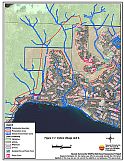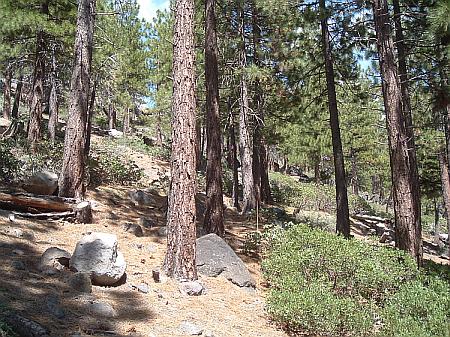Risk/Hazard Identification and Mitigation Project Worksheet
Name of Community: Incline Village
Date: July, 2004
Project Title: Incline Village Unit 6 Second Creek - Thinning and Brush Removal
Description of Risk/Hazard: Describe in detail the risk or hazard that poses a threat to the community.
Vegetative Fuel and Topography: The Incline Village Unit 6 is characterized by a dense second growth stand of Jeffery pine and white fir in the Second Creek drainage between the Upper Tyner and Saddlehorn/Tumbleweed neighborhoods and the First Creek drainage. The existing stand density is overstocked with 190 square feet of basal area per acre. Slopes are steep, over 30%, throughout the prescription area. Most of the unit has been treated with prescribed fire to reduce ground fuels, shrubs and ladder fuels. Forest health has declined, with tree mortality from insect infestation creating more dead and down fuels that could carry a fire into the tree crowns.
Worst Case Scenario / Hazard: A wind driven fire that starts in either the First or Second Creek drainages and moves upslope to the Saddlehorn/Tumbleweed neighborhood. Fire behavior in this fuel type with winds and topography would be extreme and uncontrollable.
Priority Ranking: What is the priority ranking of this risk/hazard in relation to all others identified?
With the work that has already been accomplished in the prescription area to remove ground and ladder fuels, the proposed treatment to open up the canopy would be very effective in reducing the overall fire hazard. Numerous homes with moderate access are directly uphill of the prescription area. This project is the #4 priority.
Location: Describe or attach a map with sufficient detail to allow accurate ground location.
In the Second Creek drainage between the Upper Tyner and the Saddlehorn/Tumbleweed neighborhoods. See Figure 7-7.
Recommended Mitigation Measures and Scope of Work: Present prescription and work specifications in sufficient detail to facilitate procurement of bids and quotes. For hazardous fuel removal projects include estimated volumes (tons/acre) of fuel removed and disposal plan.
The entire prescription area needs to be thinned to reduce fuel loadings and increase forest health. Thin from below, removing smaller trees and leaving larger ones to achieve the desired stocking rate of 80 to 100 square feet of basal area per acre. Steep slopes require the work to be completed by hand or aerial systems. A cable yarder could be effective in treating part of this area, however, cable systems are listed as a ground based system by TRPA. Remove or burn slash from the thinning operation. The objective is to thin the stand to open the tree canopy, and allow the heat of a ground fire to vent through the crowns, lowering fire intensity and preventing a crown fire.
*Prescribed fire could be used to maintain the effects of the previous treatment, and desired where feasible to return fire to the landscape. It should only be applied in areas after thinning and slash pile burning are complete to maintain fire control.
Evaluation of the Extent to Which Completion of This Project Will Reduce the Fire Threat:
Treating this area will enhance effects of the previous treatments. Not only will this treatment protect the community from fires moving downhill towards the neighborhoods, it will reduce the fire intensity immediately adjacent to the neighborhood. It may also help prevent a fire from escaping the neighborhood, reducing its rate of spread and aiding access during suppression efforts. Implementation of the prescription will reduce the competition among residual trees, increasing forest health and decreasing tree mortality. This will reduce the amount of accumulated dead and down material contributing to the fuel loadings on the forest floor. Thinning will also increase the spacing between residual trees, allowing heat from a ground fire to escape through the canopy, lowering fire intensity and decreasing the ability of the stand to carry a crown fire.
If all of the recommendations in this report are implemented, there is still no guarantee that a devastating wildfire will not occur in the Incline area. However, community awareness and individual attention to fuels management on private property and fuel reduction on state, federal, and county property will help to achieve the highest level of wildfire safety possible.
Identification of Protected Species or Other Critical Resources: Describe any measures that must be taken to protect critical wildlife habitat, historic
Environmental compliance measures must be implemented before project initiation. Stream Environment Zones are located in the project area and must be protected, employing appropriate TRPA mitigation measures.
Some threatened and endangered species exist in the Tahoe Basin. Appropriate avoidance and mitigation measures should be employed during project implementation.
Compliance with cultural resource protection may also be necessary. Check with TRPA and the NVSHPO to ensure cultural resources are protected.
Post-project Rehabilitation: Present scope of work in sufficient detail to facilitate procurement of bids and quotes.
Rehabilitate any fire control lines, landings or disturbed areas. Rehabilitation will be minimal if only hand methods are used. Where soil has been disturbed, TRPA rehabilitation measures and Best Management Practices would apply. This could include reseeding or mulching areas if necessary.
Estimated Timeline:
Desirable time of year to complete:
May - December.
Estimated time required to complete project:
Possibly 3 operational seasons for hand treatment. One season for aerial systems.
Estimated Cost: Present an estimate of the total cost of project completion and the basis for the estimate presented. If the project can be subdivided into phases or various components, present an estimated cost for each.
Cable yarding is recommended, however, no costs for cable yarding were available. The costs below are a minimum based on currently accepted methods in the Tahoe Basin.
| Hand cut, pile, and burn | $2,000 / acre X 524 acres | |
| Prescribed fire within 5 years | $1,200 / acre X 524 acres | |
| Total Cost | $ 1,676,800 |
Biomass to be removed is approximately 47 tons / acre
Project Maintenance Requirements:
Re-thin in 15 - 20 years.
Re-burn at 10 yr. Intervals.
Other Considerations: Describe any other considerations that must be taken into account to successfully complete this project such as permits, clearances, approvals, etc.
- TRPA Tree Removal Permit
- State (NDF) Timber Harvest Permit
- State (NDF) Stream Zone Permit
- Air Quality Permit (Washoe County)
Figure 7-7Proposed Prescription Area Incline Village Unit 6 |
 |

